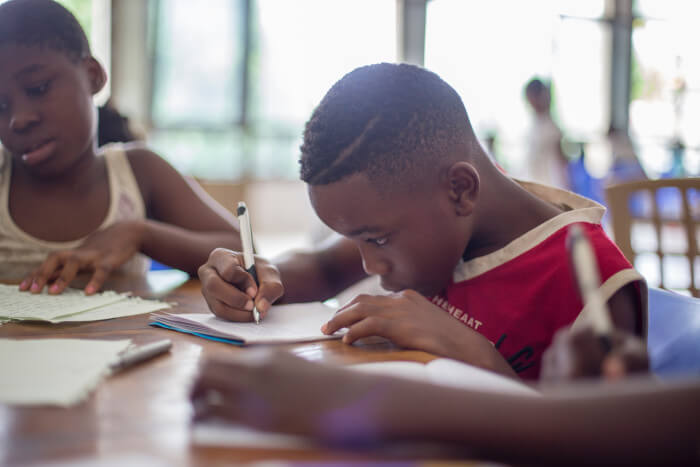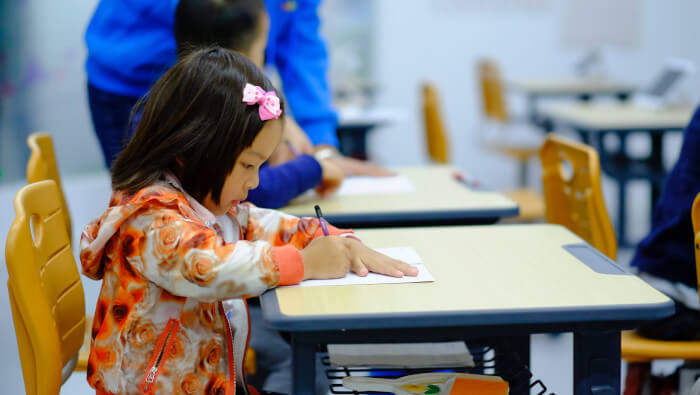A room full of seventh graders sat silently, wide-eyed, and intrigued. The lunch bell rang. No one moved. In fact, no one even seemed to notice or care that it was time to leave — each of the twenty-six students, even those who lived for lunchtime, were fully engaged.
Sounds too good to be true, doesn’t it?
So what exactly was keeping my students so engaged? I was reading “Tuck Everlasting” aloud, and it had gotten to a pivotal point in the story. Students had been assigned speaking roles for the dialogue and some had incorporated carefully crafted accents for their parts. The bottom line? This was a class of clearly engaged students. Having a group of thirteen-year-olds disregard the lunch bell felt like a crowning achievement and was a major indicator of engagement.
Want to know how you can determine which students are engaged and which ones could use a nudge? Read on to discover what signs show
The 8 indicators of student engagement

1. Participation
Naturally, students who are engaged will be participating in your class. This will look different depending on the types of learners you have — some students will participate through raising their hands and getting involved in discussions, while others will quietly devote their rapt attention to the activity at hand (personally, I was the latter as a student!). However it’s displayed, participation is directly tied to engagement, so if you spot it, you know you’re doing something right.
Not seeing it? Try this: Ensure your students know how to participate by providing clear roles. Give them specific ways to get involved that play to their individual strengths, such as classroom responsibilities, group roles, etc.

2. Pride
Engaged students will take pride in the quality of the work they produce — they’ll be proud of accomplishments and invested in their own learning outcomes. If your students are happy to show off what they’ve created or the progress they’ve made, you can easily bet that they’re engaged in your class!
Not seeing it? Try this: Instill pride by praising a job well done and letting students know you acknowledge and appreciate their efforts. Display creative projects and give regular shout-outs to students for giving it their all.

3. Proactivity
If you see signs of students being proactive with their own learning, this is another indicator of engagement. What does this look like in practice? It may mean some students are taking a real initiative in their learning. Examples include recognizing when there’s an area they need to put more effort into and taking steps to increase that effort, being proactive about seeking help when they need it, and independently seeking extensions to their learning.
Not seeing it? Try this: Help students set goals until they can assume a more proactive role in their own education. Model this behavior, and explain what proactivity looks like and how it can benefit your students. Provide opportunities for students to seek out additional knowledge and learn more beyond what you teach them. For example, you could post a list of research topics for mini-projects on your classroom wall whenever students want to learn more.

4. Passion
Passion in learning will look like genuine enthusiasm and joy for the subject or activity. Students will have a zest for their education and will be keen to learn more — and do more. They’ll also be happy to just be in your class! (At least most of the time … we’re all human after all. Don’t be discouraged by the odd “off” day!)
Not seeing it? Try this: Passion breeds passion. If you’re enthusiastic about teaching, students will be more likely to feel the same about learning. So get excited! If you’re having a hard time, find an angle to the lesson that’s most topical or interesting and double-down on that. Alternatively, let students to zero-in on the aspect of the topic that interests them the most.

5. Patience
Students who are engaged in the classroom will exhibit more patience — for understanding the topics, for themselves and for their classmates. Some of your more boisterous students (or those who are highly passionate) may have more difficulty with exercising patience, even if they are engaged. But patience is the general vibe of an engaged class of students — because if you enjoy something, you’re more willing to endure any transient boredom or slow progress.
Not seeing it? Try this: As with passion, model patience as much as possible. Also, be sure to provide adequate time for students to learn new concepts so they don’t feel discouraged if they don’t immediately understand things. Additionally, remind students that understanding new topics can take some time.

6. Peace
Peace and quiet — an elusive sight in many classrooms! But it’s definitely attainable. Students who are engaged will be focused and happy to be involved in classroom activities. This will, in turn, minimize disruptions in the class and keep noise levels and misbehavior to a low. Engaged students are also less likely to get frustrated or to show a negative attitude towards your class.
Not seeing it? Try this: Create a physical space of peace. During certain activities, try playing serene classical music at a low volume. If silence and lower lighting work better for your group, make sure that’s available whenever it’s appropriate. Think zen and the peace will naturally follow.

7. Playfulness
No matter the grade level, a certain degree of playfulness is encouraged and definitely an indicator of engagement. Are your students eager to get involved in creative projects, whether in groups or independently? Are students laughing in a friendly way when you make jokes, or able to laugh a little at themselves during the learning process? Engaged students will feel comfortable and relaxed in your classroom, and this will make it easier for them to open up and have fun. And when students have fun, they enjoy (and retain) whatever they’re learning.
Not seeing it? Try this: Ice-breaker games can work even in the middle of the school year and can be incorporated into any grade level or subject. For example, you could gamify your classroom with Classcraft to inject some extra fun and creativity into your routine. Students will benefit academically from the range of quests and tools Classcraft offers while also remaining engaged thanks to the play factor.
Check out the video below to hear how one teacher uses Classcraft to energize their remote teaching, develop and maintain a fun connection with their students, and facilitate student engagement — even from thousands of miles away.
Think outside the box, and watch your students flourish!

8. Perseverance
Engaged students want to see things through! This is closely tied to patience and peace. If you notice students are giving up quickly and that frustration is leading the way, you might want to check in on their engagement. Students who feel engaged in the classroom are more likely to want to persevere through tough subjects and assignments. They’ll want to try harder to achieve bigger and better things because they’ll be invested in their learning process.
Not seeing it? Try this: Encourage, encourage, encourage! Help students with goal-setting — set small, achievable goals, and inspire students to persevere. Remind them of any notable accomplishments they’ve had, and set up small rewards for both class and individual achievements.
Increased student engagement = easier classroom management
Hopefully, these eight indicators of student engagement will help guide your classroom management strategy in the right direction. Student engagement can take on different forms and will, of course, vary from one day to another. If you’re seeing a combination of the above indicators flowing through the majority of the school days, you’re definitely on the right track. If you feel like engagement is lacking, though, try out some of these tips. In any case, know that an engaged class will be easier to manage, and learning outcomes will be met more frequently. So lead the way and watch the benefits roll in!
Photo credit: Zach Vessels / Unsplash.com
Student Engagement


